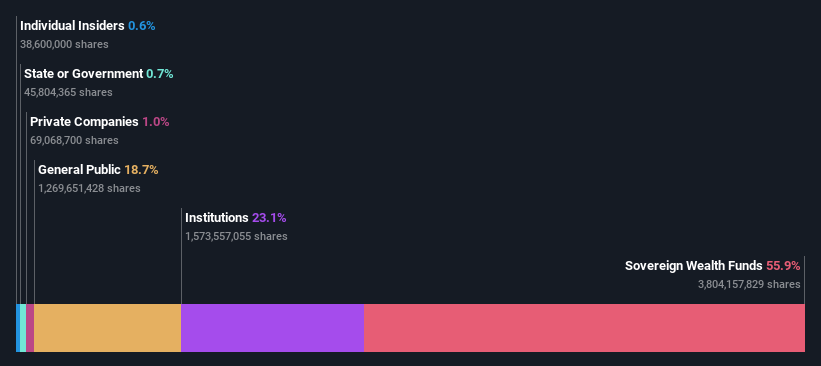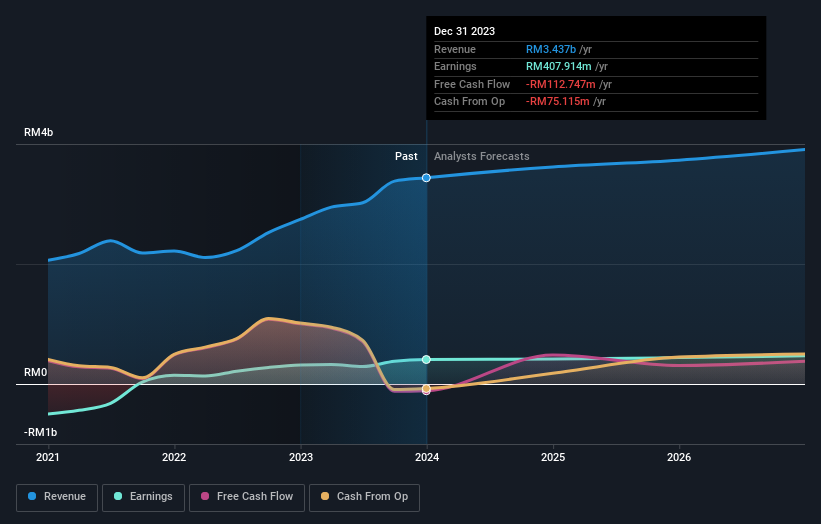Institutions own 23% of Sime Darby Property Berhad (KLSE:SIMEPROP) shares but sovereign wealth funds control 56% of the company
Key Insights
Sime Darby Property Berhad's significant sovereign wealth funds ownership suggests that the key decisions are influenced by shareholders from the larger public
56% of the company is held by a single shareholder (Permodalan Nasional Berhad)
Institutional ownership in Sime Darby Property Berhad is 23%
If you want to know who really controls Sime Darby Property Berhad (KLSE:SIMEPROP), then you'll have to look at the makeup of its share registry. With 56% stake, sovereign wealth funds possess the maximum shares in the company. In other words, the group stands to gain the most (or lose the most) from their investment into the company.
And institutions on the other hand have a 23% ownership in the company. Institutions often own shares in more established companies, while it's not unusual to see insiders own a fair bit of smaller companies.
Let's delve deeper into each type of owner of Sime Darby Property Berhad, beginning with the chart below.
Check out our latest analysis for Sime Darby Property Berhad
What Does The Institutional Ownership Tell Us About Sime Darby Property Berhad?
Institutions typically measure themselves against a benchmark when reporting to their own investors, so they often become more enthusiastic about a stock once it's included in a major index. We would expect most companies to have some institutions on the register, especially if they are growing.
As you can see, institutional investors have a fair amount of stake in Sime Darby Property Berhad. This suggests some credibility amongst professional investors. But we can't rely on that fact alone since institutions make bad investments sometimes, just like everyone does. If multiple institutions change their view on a stock at the same time, you could see the share price drop fast. It's therefore worth looking at Sime Darby Property Berhad's earnings history below. Of course, the future is what really matters.
We note that hedge funds don't have a meaningful investment in Sime Darby Property Berhad. Looking at our data, we can see that the largest shareholder is Permodalan Nasional Berhad with 56% of shares outstanding. This implies that they have majority interest control of the future of the company. Kumpulan Wang Persaraan is the second largest shareholder owning 6.6% of common stock, and Employees Provident Fund of Malaysia holds about 4.7% of the company stock.
While studying institutional ownership for a company can add value to your research, it is also a good practice to research analyst recommendations to get a deeper understand of a stock's expected performance. There are a reasonable number of analysts covering the stock, so it might be useful to find out their aggregate view on the future.
Insider Ownership Of Sime Darby Property Berhad
While the precise definition of an insider can be subjective, almost everyone considers board members to be insiders. The company management answer to the board and the latter should represent the interests of shareholders. Notably, sometimes top-level managers are on the board themselves.
I generally consider insider ownership to be a good thing. However, on some occasions it makes it more difficult for other shareholders to hold the board accountable for decisions.
Our most recent data indicates that insiders own less than 1% of Sime Darby Property Berhad. However, it's possible that insiders might have an indirect interest through a more complex structure. Keep in mind that it's a big company, and the insiders own RM34m worth of shares. The absolute value might be more important than the proportional share. Arguably, recent buying and selling is just as important to consider. You can click here to see if insiders have been buying or selling.
General Public Ownership
The general public-- including retail investors -- own 19% stake in the company, and hence can't easily be ignored. While this size of ownership may not be enough to sway a policy decision in their favour, they can still make a collective impact on company policies.
Next Steps:
It's always worth thinking about the different groups who own shares in a company. But to understand Sime Darby Property Berhad better, we need to consider many other factors. Case in point: We've spotted 1 warning sign for Sime Darby Property Berhad you should be aware of.
But ultimately it is the future, not the past, that will determine how well the owners of this business will do. Therefore we think it advisable to take a look at this free report showing whether analysts are predicting a brighter future.
NB: Figures in this article are calculated using data from the last twelve months, which refer to the 12-month period ending on the last date of the month the financial statement is dated. This may not be consistent with full year annual report figures.
Have feedback on this article? Concerned about the content? Get in touch with us directly. Alternatively, email editorial-team (at) simplywallst.com.
This article by Simply Wall St is general in nature. We provide commentary based on historical data and analyst forecasts only using an unbiased methodology and our articles are not intended to be financial advice. It does not constitute a recommendation to buy or sell any stock, and does not take account of your objectives, or your financial situation. We aim to bring you long-term focused analysis driven by fundamental data. Note that our analysis may not factor in the latest price-sensitive company announcements or qualitative material. Simply Wall St has no position in any stocks mentioned.

 Yahoo Finance
Yahoo Finance 

